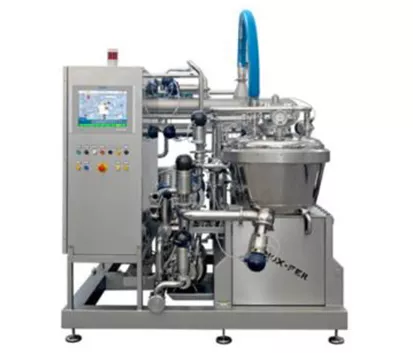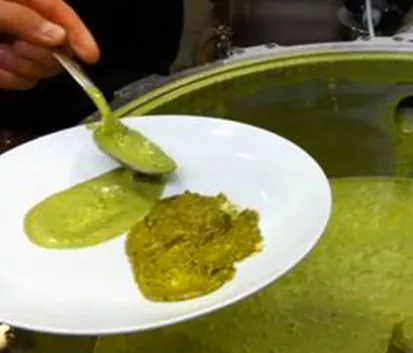Sommario
This month our article is dedicated to “How to produce Pesto sauce”. This pesto is one of the most familiar and popular examples of mediterranean cuisine. Traditionally, it consists of crushed garlic, basil, coarse sea salt and pine nuts blended with parmesan cheese and olive oil.
Large scale production of Pesto sauce is a fascinating process. Maintaining the traditional characteristics of this recipe and cooking method while preserving the nutritional and organoleptic qualities of the Pesto during industrial production can be preserved thanks to the vacuum cut carried out by the Inox-Fer ProCut Cutter.

ProCut Cutter Industrial Cooking Kettle Machine For Pesto Production
The ProCut Cutter Industrial Cooking Kettle allows easy management of cutting, mixing and discharging phases. All manufacturing functions to produce Genovese Pesto, while still respecting European Food Hygiene standards and the traditional Italian recipe, are completely automated.
Furthermore, with our ProCut Cutter you can run in a complete pasteurization cycle. Pasteurization is necessary to thermally stabilize the product and increase its shelf life. The ProCut Cutter aids in the minimization of color change and oxidation of the Pesto. We can also load phases automatically via software with a touch-screen interface PLC.
Steps to produce Genovese Pesto:
HARVEST
Harvest: The first thing to check is the quality of the basil and its compliance with European Food Law Regulations.
WASHING & RINSING
Washing and Rinsing : Harvested basil is then washed by utilizing a swirling stream of purified, clean water. Special nozzles spray this water on the processing basil until this phase is complete.
DRYING
Drying: The washed basil is spun using centrifugal force until all water residue is removed.

CUTTING & MIXING
Washed basil is integrated with pine nuts, parmesan cheese, crushed garlic and coarse sea salt inside the ProCut Cutter to be cut and mixed with the introduction of olive oil. The block with three double toothed blades ensures optimal processing of the mixture throughout the entire volume of the tank in a perfect balance. The side stirrer feature prevents the product from sticking to the side of the tank and facilitates uniform cutting. Another important advantage of the ProCut Cutter is the engine position. By placing the engine on the back of the frame, and not directly under the tank, we avoid the possibility of any product coming into contact with electrical parts in the event of a leak.
The Genovese Pesto produced with the ProCut Cutter is more brilliant than that of our competitors.
DISCHARGING
Internal tank pressurization facilitates the discharge pump for efficient product output. The bottom stirrer removes the presence of the product on the bottom of the tank during discharge. Meanwhile, the C.I.P. washing unit cleans and sterilizes the entire machine automatically following discharge.
PACKAGING & LABELING
Pasteurized Pesto from the ProCut Cutter is then filled directly into jars. If cold mixing is required, a bit of oil is added to raise the shelf life, and to avoid any surface oxidation, during packaging. Finally, the jar is labelled, according to European Food Hygiene standards, and is ready for the market.
